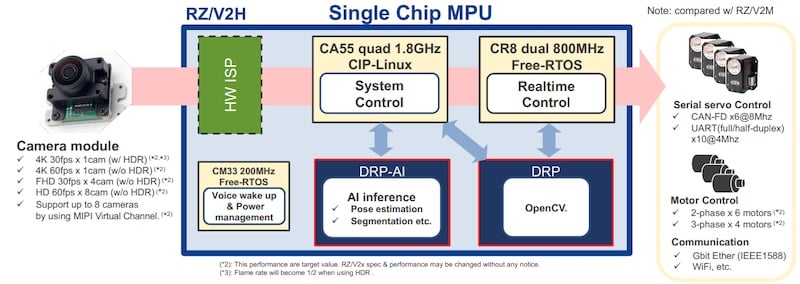Renesas Unveils New Edge AI MPU: High Performance with Low Power
Renesas Electronics Corporation has announced the RZ/V2M microprocessor (MPU), a new addition to its RZ/V2 series of AI-capable MPUs. The RZ/V2M is designed to deliver high performance and low power consumption for edge AI applications such as smart factories, smart cities, and industrial automation.

The new RZ/V2H for edge AI applications
The microprocessors within Renesas' RZ/V series are all multi-core and tailored for localized machine vision processing. The newly introduced RZ/V2H raises the bar by introducing extra cores, improved processing speeds, and reduced power usage. It boasts a performance capacity of up to 80 tera operations per second (TOPs) when running Resnet50, which is a 50-layer deep convolutional neural network model.

Renesas 64-bit RZ/V vision AL MPU product line
It also includes AI classification models at efficiencies of up to 10 TOPs per watt. For comparison, the prior MPUs in the family top out at 1 TOP and 28 fps with Resnet50.
Featuring a Robust Multi-Core Configuration
Renesas' RZ/V2H is equipped with an array of cores including a quad-core Cortex-A55, a dual-core Cortex-R8, a single Cortex-M33, along with Renesas' own DRP, DRP-AI, and an optional hardware image signal processor (ISP). The A55 cores often operate Linux, handling system management and core processing tasks. This quad-core setup empowers the MPU to manage four 4K cameras concurrently, with a processing speed reaching up to 830 frames per second. Tasks demanding prompt execution, such as regulating motors and handling communication protocols, can be allocated to the R8 cores. Meanwhile, less urgent tasks, like power management and initiation procedures, are efficiently taken care of by the 200-MHz M33 core.

RZ/V2H application diagram.
The built-in hardware image signal processor (ISP) serves as the initial processing point for image data received from cameras. Recognizing the variation in camera technology, with some having embedded ISPs, Renesas has made the RZ/V2H available both with and without the hardware ISP component. The processors' DRP and DRP-AI sections ensure OpenCV compatibility and handle a substantial portion of the AI workload. These capabilities render the processor highly suitable for driving smart appliances in homes and offices, devices for industrial safety, and infrastructure technology. They endow devices with the ability to perform AI tasks such as image analysis, recognition, and decision-making processes autonomously, only resorting to server assistance for exceptionally complex AI tasks. Further details are attainable in the RZ/V2H technical datasheet.
Enhanced Processing Power with Reduced Power Consumption
In scenarios where limited space necessitates stringent power and thermal constraints, simply increasing the number of cores or boosting clock frequencies isn't a viable approach to enhance performance. The RZ/V2H stands out in this aspect, offering not just additional cores and high clock rates, but also achieving performance gains through strategic optimization for greater efficiency and lower power usage.
The RZ/V2H features Renesas' unique dynamically reprogrammable processor (DRP), an adaptable engine capable of being reconfigured for assorted operations, even potentially modifying its configuration with each tick of the clock. Within the RZ/V2H, the DRP takes charge of preliminary and ancillary processing tasks, ensuring OpenCV compatibility. Meanwhile, the DRP-AI—fine-tuned specifically for AI-related calculations—manages the most demanding AI tasks. Renesas asserts that the V3 model delivers a tenfold enhancement in energy efficiency compared to its V2 predecessor.
Switching from FP16 used in the previous DRP-AI V2 to INT8 data quantization for matrix computations may appear as a drastic change. However, in this context, it doesn't result in significant loss. The MPU, utilizing the Resnet50 model, sustains high precision even with INT8 data. This transition to INT8 data not only yields a fourteenfold increase in computational throughput but also brings about a twofold improvement in energy efficiency over FP16 due to the reduced data size.
Unstructured Pruning in the DRP
A process called unstructured pruning brings further performance increases and power reductions. An AI model looks at weighted values, with larger values having more significance and a greater likelihood of leading to a match. Pruning takes all the weights that are near zero and sets them to zero.

FP16 with no pruning in earlier MPU versions (left) and INT8 with sparse pruning in the RZ/V2H (right).
Since the result would be zero with no value toward the ultimate result, the DRP-AI engine skips any operation with a weight equaling zero. Leaving the zero weights in is called dense pruning, while skipping them is referred to as sparse pruning. This makes the AI model smaller, faster, and more efficient, for about 5x improvement in power efficiency on top of the 2x gained with the switch from FP16 to INT8.
According to Renesas benchmarks, the combination of INT8 and sparse pruning significantly increases performance over common competitive offerings.

Competitive benchmarks illustrating performance advantages of RZ/V2H
Dense pruning delivers twice the performance, while sparse pruning takes it further to about a 3x increase in AI performance. In a typical application where a device must process video, identify objects, and make decisions based on the observations, the AI computation speed in the processor translates directly to the speed of the device operations. Robots can move faster, alarms can be triggered faster, and any necessary responses can start sooner.
No Fans Needed
The DRP and DRP-AI increase performance and significantly reduce power consumption compared to competitive GPU-based embedded AI. In a robotic vacuum use case, the RZ/V2H delivers 13 fps for AI simultaneous localization and mapping (SLAM) at less than 4 W, negating the need for cooling fans in most applications. That means quieter operation and longer battery life. The RZ/V2H is available as a component and development board for purchase now from standard Renesas distribution channels.
BonChip Electronics, a trusted distributor of the entire Renesas product line, offers the RZ/V2M alongside a comprehensive portfolio of edge AI solutions, exceptional technical support, and efficient order processing. Contact us today to explore how the RZ/V2M can empower your next edge AI project.
Unleashing Performance and Efficiency:
The RZ/V2M offers several key advantages for edge AI applications:
- High Performance:
- Dual-core Arm Cortex-A78 CPU: Delivers up to 5.5 CoreMarks/MHz performance.
- AI accelerator: Supports up to 4.8 TOPS INT8 performance.
- Low Power Consumption:
- Advanced power management features: Achieve low power consumption in both active and standby modes.
- Typical power consumption of 2.5 W: Ideal for battery-powered applications.
- Scalability:
- Available in a variety of packages: BGA156, BGA256, and LGA256.
- Supports up to 16 GB of LPDDR4x memory: Can handle large data sets for AI applications.
Ideal for Diverse Edge AI Applications:
The RZ/V2M is ideal for a wide range of edge AI applications:
- Smart factories:
- Predictive maintenance: Monitor and analyze machine data to prevent downtime.
- Quality control: Inspect products for defects using AI-powered vision systems.
- Smart cities:
- Traffic management: Optimize traffic flow using real-time data analysis.
- Public safety: Monitor and analyze video footage for security purposes.
- Industrial automation:
- Collaborative robots: Enable robots to work safely and efficiently alongside humans.
- Machine vision: Inspect products and processes for defects.
Renesas RZ/V2M Delivers the Performance and Efficiency You Need for Your Next Edge AI Application. Contact BonChip Electronics Today to Learn More!
Labels:
Renesas,
RZ/V2M,
Edge AI,
MPU,
High Performance,
Low Power,
Smart Factories,
Smart Cities,
Industrial Automation







